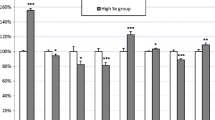Summary
We studied whether lead exposure increased the serum lipid peroxide (LPO) level and inhibited blood superoxide dismutase (SOD) activity in workers with occupational exposure to lead and rats injected with lead. We examined the following subjects: (1) manual workers (712 males) from 18 to 59-years-old in steel production with occupational exposure to lead, (2) office workers (155 males) without exposure to lead, (3) rats subcutaneously injected with lead in concentrations of 10 or 20 mg/kg as lead acetate. The nutritional intakes of manual workers and office workers were approximately equal. Serum LPO and high-density lipoprotein cholesterol (HDL-CL) levels in manual workers (LPO: 4.4 ± 1.9 nmol/ml, HDL-CL: 55.6 ± 14.2 mg/dl) were significantly higher than those in office workers (LPO: 4.0 ± 1.4 nmol/ml, HDL-CL: 53.0 ± 13.9 mg/dl). Serum LPO level in the manual workers increased with an increase of the lead concentration in the blood, while blood SOD activity decreased. Similar phenomena were observed in rats subcutaneously injected with lead acetate. Furthermore, the addition of lead at higher than 20-μM concentrations to non-treated rat liver microsomes increased NADPH-dependent lipid peroxidation, and these lead concentrations inhibited bovine erythrocyte SOD activity in vitro assay system. In conclusion, the present results seem to indicate that the increase of serum LPO level in workers with occupational exposure to lead is due not only to the stimulation of lipid peroxidation, but also to the inhibition of SOD activity by exposure to lead in the manufacturing processes.
Similar content being viewed by others
References
Aust SD, Svingen BA (1976) The role of iron in enzymatic lipid peroxidation. In: Pryor WA (ed) Free radicals in biology, vol V. Academic Press, New York, pp 1–18
Berlin A, Schaller KH (1974) European standardized method for the determination of aminolevulinic acid dehydratase activity in blood. Z Klin Chem Klin Biochem 12:389–390
Chisolm JJ (1978) Heme metabolites in blood and urine in relation to lead toxicity and their determination. Adv Clin Chem 20:225–265
Demopoulos HB, Flamm E, Seligman M, Pietronigro DD (1982) Oxygen free radicals in central nervous ischemia and trauma. In: Autor AP (ed) Pathology of oxygen. Academic Press, New York, pp 127–155
Fridovich I (1975) Superoxide dismutase. Ann Rev Biochem 44:147–159
Granick JL, Sassa S, Kappus A (1978) Some biological and clinical aspects of lead intoxication. Adv Clin Chem 20:287–339
Kellogg EM, Fridovich I (1977) Liposome oxidation and erythrocyte lysis by enzymatically generated superoxide and hydrogen peroxide. J Biol Chem 252:6721–6728
Mead JF (1976) Free radical mechanism of lipid damage and consequences for cellular membranes. In: Pryor WA (ed) Free radicals in biology, vol 1. Academic Press, New York, pp 51–68
McCord JM, Fridovich I (1969) Superoxide dismutase. An enzymatic function for erythrocuprein (hemocuprein). J Biol Chem 244:6049–6055
Minami M, Yoshikawa H (1979) A simplified assay method of superoxide dismutase activity for clinical use. Clin Chim Acta 92:337–342
Minami M, Koshi K, Homma K, Suzuki Y (1982) Changes of the activities of superoxide dismutase after exposure to the fume of heavy metals and the significance of zinc in the tissue. Arch Toxicol 49:215–225
Ribarov SR, Benov LC, Benchev IC (1981) The effect of lead on hemoglobin-catalyzed lipid peroxidation. Biochim Biophys Acta 664:453–459
Rothstein M (1982) Biochemical approaches to aging. Academic Press, New York, pp 41–73
Searle B, Chan W, Davidow B (1973) Determination of lead in blood and urine by anodic stripping volatammetry. Clin Chem 19:76–80
Shinohara R, Ogishi K, Nagamura Y, Makino H, Ishiguro I (1976) Application of superoxide dismutase to clinical chemistry. Jpn J Clin Pathol 24:928–930 (in Japanese)
Stacey NH, Kappus H (1982) Cellular toxicity and lipid peroxidation in response to mercury. Toxiol Appl Pharmacol 63:29–35
Tappel AL (1973) Lipid peroxidation damage to cell components. Fed Proc 32:1870–1874
Vladimirov YA, Olenev VI, Sualova TB, Cheremisina ZP (1980) Lipid peroxidation in mitochondrial membrane. Adv Lipid Res 17:173–249
Wills (1969) Lipid peroxide formation in microsomes. Biochem J 113:325–332
Yagi K (1976) A simple fluorometric assay for lipoperoxide in blood plasma. Biochem Med 15:212–216
Author information
Authors and Affiliations
Rights and permissions
About this article
Cite this article
Ito, Y., Niiya, Y., Kurita, H. et al. Serum lipid peroxide level and blood superoxide dismutase activity in workers with occupational exposure to lead. Int Arch Occup Environ Health 56, 119–127 (1985). https://doi.org/10.1007/BF00379383
Received:
Accepted:
Issue Date:
DOI: https://doi.org/10.1007/BF00379383



